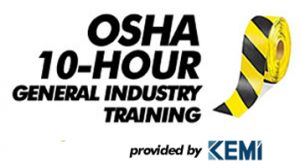Course Content
The OSHA 10-Hour General Industry Training covers material set forth by the OSHA Outreach Training Program. Courses are provided through formal instruction accompanied with handouts, case studies, and student interaction. The OSHA Outreach Training Program for General Industry provides training for workers and employers on the recognition, avoidance, abatement, and prevention of safety and health hazards in workplaces covered under 29 CFR 1910. Upon successful completion of the class, students will receive a 10-hour course completion card from the Occupational Safety and Health Administration in General Industry Safety. Participants will gain basic knowledge on the following topics:
 Introduction to OSHA.
Introduction to OSHA.- Egress & fire protection.
- Walking & working surfaces.
- Machine guarding.
- Hazard communications.
- Electrical safety.
- Personal protective equipment (PPE) & lifesaving equipment.
- Ergonomics.
Course Length
Plan to allow an adequate amount of time for your class. OSHA 10-Hour General Industry Training must be conducted over two days per OSHA Outreach Training Program guidelines. Frequent breaks will be taken to allow participants to remain fresh and alert. A 30-minute lunch break will be taken on the first day of training.
Accommodations
KEMI will provide all training materials needed for the class. This class can be taught at the policyholder’s facilities provided there is a meeting room with tables and chairs.
Cost
This OSHA 10-Hour General Industry Training is provided by KEMI exclusively to policyholders. There is an administrative fee of $10.00 per individual due at registration to cover the cost of the completion cards issued to each participant.
Course Details
Please see a detailed explanation of each section as well as the section duration outlined below. The asterisk symbol (*) by the section name denotes mandatory subjects required by the OSHA Outreach Training Program for General Industry.
*Introduction to OSHA: The purpose is to provide workers with introductory information about OSHA. Topics discussed include: why is OSHA important to you, what rights do you have under OSHA, what responsibilities does your employer have under OSHA, what do the OSHA standards say, how are OSHA inspections conducted, and where can you go for additional help. Duration: 2 hours.
*Electrical: The electrical presentation covers the dangers of electricity, common injuries associated with coming into contact with electricity, safety measures to take, site conditions that produce exposure to electricity and proper controls, Personal Protective Equipment use required for protection from electricity. Duration 90 minutes.
*Exit Routes, Emergency Action Plans, Fire Prevention Plans, and Fire Protection: Egress and Fire Protection provides participants with information related to fire and explosion hazards in the workplace. Much of this course is geared toward life safety and covers topics such as: Basic requirements for emergency exit routes and fire extinguishers, evacuation plans, fire brigades, training requirements and other topics related to facility safety. Duration: 1 hour.
*Walking and Working Surfaces: This presentation discusses the OSHA standard which deals with the issues of slips, trips and falls in the workplace. Participants will gain knowledge in regards to the basic requirements for stairs & ladders, guarding of floor and wall openings and the basics of fall protection in General Industry. Participants will also gain basic knowledge in the safe usage of ladders. Duration: 1 hour.
*Personal Protective Equipment: This presentation covers the use of engineering controls, work practice controls, and the use of Personal Protective Equipment for safety and health concerns. Included in the presentation is the type of PPE required to protect various parts of the body, and the pros and cons to each. Duration: 1 hour.
*Hazard Communications: The Hazard Communication standard 1910.1200 is discussed in this presentation in terms of what the Standard requires, what is needed in a written program, chemical labeling requirements, reading a Material Safety Data Sheet, and the training requirements for employees. Duration: 1 hour.
Machine Guarding: This portion of the class covers basic requirements for the safe guarding of machinery to prevent accidental contacts by operators and by-standers. During this course participants will learn the main concepts of machine guarding which include: Point of operation guarding, methods for machine guarding, basic requirements for guarding moving parts such as belts and pulleys and training requirements. Duration: 1 hour.
Ergonomics: During the ergonomics portion of the class participants gain knowledge related to body mechanics, healthy postures, repetitive motion and injuries related to over exertion of the body. Participants will also learn valuable techniques for improving workstation designs and prevention measures for injuries such as carpal tunnel. Duration: 30 minutes.
Materials Handling: This presentation covers the lifting of materials both manually and with the use of equipment. The hazards of each are discussed along with the use of chains, wire rope, and nylon slings. Control measures and training requirements for work with these components as well as with manual lifting are discussed at length. Duration: 1 hour.
Bloodborne Pathogens: This presentation reviews bloodborne hazards in the workplace from a discussion of who is at risk and how employees can be exposed to these hazards. Exposure Control Plans are reviewed along with engineering controls, work practice controls, personal protective equipment, and training requirements needed to protect employees when exposed to bloodborne disease. Duration: 1 hour.
Flammable Liquids: During this presentation participants will gain knowledge in flammable and combustible liquids and safety precautions needed for safe transfer, use, and storage. Duration: 30 minutes.

